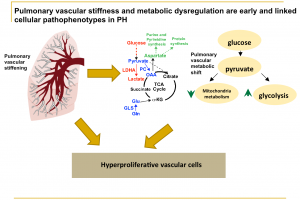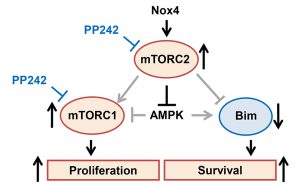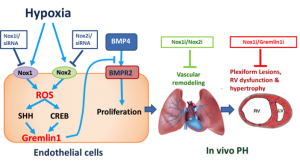Recent Discoveries
microRNAs as systems-level regulators of PAH
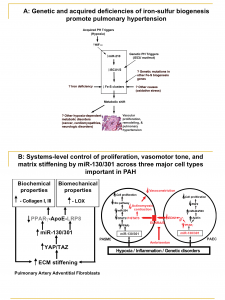 The Chan lab was the first to identify the crucial systems-level functions of microRNAs in PH and the first to demonstrate the validity of network theory in predicting in vivo pulmonary vascular function.
The Chan lab was the first to identify the crucial systems-level functions of microRNAs in PH and the first to demonstrate the validity of network theory in predicting in vivo pulmonary vascular function.
- We developed an in silico approach to rank microRNAs by their targeting patterns of known networks of PH-relevant genes. By coupling these efforts to experimental validation in both animal and human PH models, we identified the top-ranked microRNA family, miR-130/301, as a master regulator of multiple subordinate microRNA pathways with coordinated effects in PH (A) 1, 2.
- Separately, we identified the hypoxia-induced miR-210 as an essential regulator of oxidative metabolism in PH, via repressing the iron-sulfur cluster assembly proteins ISCU1/2 and perturbing mitochondrial respiration. As such, we defined a new human cohort of patients carrying genetic mutations of ISCU1/2 who suffer from exercise-induced PH (B) 3-6.
These seminal findings identified miR-130/301 and the miR-210-ISCU1/2 axis at the crucial pathogenic origin of PH and thus offered new therapeutic possibilities now under active clinical investigation. Perhaps most importantly, our work is the cornerstone of evolving applications of network theory to the discovery of the RNA-based origins of many other human diseases.
Contact:
Stephen Y. Chan, MD, PhD | Bio
YAP/TAZ (HIPPO signaling) as central regulators of proliferation/vascular stiffness in PAH
Alterations in vascular stiffness and cellular metabolism occur in cardiopulmonary diseases, including pulmonary hypertension (PH). For PH, there is optimism that identifying the early molecular and metabolic triggers of disease will yield more robust therapeutic targets to prevent or regress disease. Over the past years, the Chan lab has studied emerging mechanisms by which the biophysical properties of extracellular matrix (ECM) control pulmonary vascular metabolic processes.
- We have found that vascular ECM remodeling and stiffening are early and pervasive processes that promote PH. In multiple pulmonary vascular cell types and in PH samples from rodents, primates, and humans, ECM stiffening mechanoactivated the transcriptional coactivators YAP and TAZ, leading to alterations of matrix remodeling and cellular metabolism. Specifically, YAP/TAZ induced the microRNA-130/301 family to promote collagen remodeling and to further upregulate YAP/TAZ via a feedback loop 3.
- Moreover, we found that mechanoactivation of YAP/TAZ in stiff ECM modulated metabolic enzymes including lactate dehydrogenase A (LDHA), pyruvate carboxylase (PC), and glutaminase (GLS1), thus inducing glutaminolysis, and anaplerosis and sustaining proliferation and migration with increased glycolysis. In vivo, pharmacologic modulation of the microRNA 130/301 family, YAP, and GLS1 independently altered pulmonary vascular stiffness, glutaminolysis, proliferation, and manifestations of PH 7.
Thus, our findings define the activation of glutaminolysis and anaplerosis as a paradigm by which vessel stiffness can stimulate proliferation in PH. These results demonstrate how vascular cells balance energetic demands with extracellular mechanical cues. Our findings also endorse the application of pharmacologic inhibitors of these pathways to prevent or reverse PH. Finally, this work may have broad application to other cardiometabolic conditions where mechanosensation dictates disease.
Contact:
Stephen Y. Chan, MD, PhD | Bio
mTORC2-AMPK axis as a key coordinator of cellular energy metabolism, proliferation and survival in PAH
We discovered a novel role for mTORC2 in PAH and showed attractiveness of mTORC2-AMPK as a new potential target pathway for therapeutic interventions for this incurable disease.
Enhanced proliferation, impaired apoptosis, and metabolic shift to glycolysis of pulmonary arterial vascular smooth muscle cells (PAVSMC) are important pathophysiological components of pulmonary vascular remodeling. mTOR is a key regulator of cell growth and metabolism that acts through two distinct complexes, mTOR complex 1 (mTORC1) and mTORC2.
- We found that both mTORC1 and mTORC2 pathways are up-regulated in small remodeled pulmonary arteries and primary distal PAVSMC from subjects with idiopathic PAH (PAH) and contribute to increased proliferation, but only mTORC2 regulates ATP levels and IPAH PAVSMC survival.
- We dissected a novel mechanistic link of Nox4-dependent activation of mTORC2 via energy sensor AMPK to up-regulation of mTORC1 and increased proliferation and to deficiency of pro-apoptotic factor Bim and elevated survival of PAVSMC in PAH
- We demonstrated that the dual mTORC1/mTORC2 inhibitor PP242 not only inhibits proliferation, but also induces apoptosis in PAVSMC from IPAH patients without significant effect on control cells, and induces apoptosis in small PAs and reverses existing pulmonary vascular remodeling in experimental model of PH.
Mammalian target of rapamycin complex 2 (mTORC2) coordinates pulmonary artery smooth muscle cell metabolism, proliferation, and survival in pulmonary arterial hypertension. [PubMed]
Goncharov DA, Kudryashova TV, Ziai H, Ihida-Stansbury K, DeLisser H, Krymskaya VP, Tuder RM, Kawut SM, Goncharova EA.
Circulation. 2014 Feb 25;129(8):864-74 [PMID 24270265]
Contact:
Elena Goncharova, PhD | Bio
HIPPO signaling as a central signaling hub regulating pulmonary vascular cell proliferation/apoptosis imbalance and pulmonary vascular remodeling in PAH
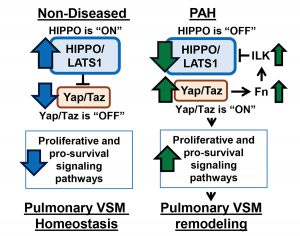
HIPPO signaling is a central regulator of vascular cell homeostasis, self-supporting inactivation of which promotes PAH; targeting this pathway reverses established disease, which makes it attractive target for therapeutic intervention.
- This study reports inactivation of HIPPO/LATS1 as a novel mechanism supporting the proliferative apoptosis-resistant PAH PAVSMC phenotype, pulmonary vascular remodeling and pulmonary hypertension.
- We describe novel self-supported pathological loop between LATS1 and integrin-linked kinase 1 as an important regulator of self-sustaining proliferation and survival of PAVSMC in PAH
- We show that pharmacological disruption of this pathological loop reverses pulmonary vascular remodeling and established PH.
HIPPO-Integrin-linked Kinase Cross-Talk Controls Self-Sustaining Proliferation and Survival in Pulmonary Hypertension. Kudryashova TV, Goncharov DA, Pena A, Kelly N, Vanderpool R, Baust J, Kobir A, Shufesky W, Mora AL, Morelli AE, Zhao J, Ihida-Stansbury K, Chang B, DeLisser H, Tuder RM, Kawut SM, Silljé HH, Shapiro S, Zhao Y, Goncharova EA.
Am J Respir Crit Care Med. 2016 Oct 1;194(7):866-877. [PMID 27119551]
Contact:
Elena Goncharova, PhD | Bio
Nitrite as a potential therapy for PH-HFpEF
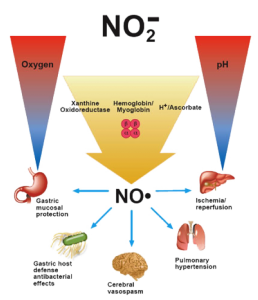
- Pulmonary hypertension associated with heart failure with preserved ejection fraction (PH-HFpEF) represents the most frequent cause of pulmonary hypertension worldwide, with no currently approved therapies.
- Recently, we developed a pre-clinical model of PH-HFpEF in rats with multiple features of metabolic syndrome attributable to double leptin receptor defect (obese ZSF1) with the combined treatment of vascular endothelial growth factor receptor blocker SU5416.
- Early treatment with nitrite improves hyperglycemia and reduces pulmonary pressures and vascular remodeling in rats with PH-HFpEF, suggesting a potential role of nitrite as a preventative treatment for this disease.
These findings are significant because there are no approved specific treatments for PH-HFpEF. Our data suggest a potential role for nitrite as preventative treatments for PH-HFpEF developing in patients with metabolic syndrome and identify skeletal muscle SIRT3 as a potential therapeutic target in the management of PH-HFpEF. Future trials of chronic oral nitrite may be considered for patients with PH-HFpEF.
Contact:
Mark Gladwin, MD | Bio
SIRT3-AMPK activation by nitrite normalizes PH-HFpEF
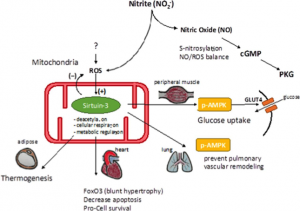
- Chronic oral nitrite treatment improved hyperglycemia in obese ZSF1 rats by a process that requires skeletal muscle SIRT3-AMPK-GLUT4 signaling.
- Early treatment with nitrite reduced pulmonary pressures and vascular remodeling in the PH-HFpEF model with robust activation of skeletal muscle SIRT3 and AMPK.
- Skeletal muscle biopsies from humans with metabolic syndrome after 12 weeks of oral sodium nitrite and nitrate treatment (IND#115926) displayed increased activation of SIRT3 and AMPK.
These findings are significant because there are no approved specific treatments for PH-HFpEF. Our data suggest a potential role for nitrite as preventative treatments for PH-HFpEF developing in patients with metabolic syndrome and identify skeletal muscle SIRT3 as a potential therapeutic target in the management of PH-HFpEF. Future trials of chronic oral nitrite may be considered for patients with PH-HFpEF.
Contact:
Mark Gladwin, MD | Bio
NOX signaling control of vascular remodeling in PAH
The pulmonary endothelium is essential for normal vascular homeostasis in the lung. Loss of endothelial integrity is broadly accepted as a major trigger that underlies many vascular diseases, including PAH. The pathogenesis of PAH includes sustained vasoconstriction and abnormal structural remodeling of small pulmonary arteries and arterioles due to endothelial dysfunction and proliferation of smooth muscle cells (SMCs). NADPH oxidase (Nox)-dependent reactive oxygen species are involved in vascular function, e.g. vascular tone and vascular remodeling. Our laboratory is focused on dissecting the role of Nox and other important mediators in the progression of PAH with the long term goal of identifying targets of potential therapeutic value.
- Our findings demonstrate that Nox1-derived ROS mediate proliferation of human pulmonary arterial EC (HPAECs) as well as increased expression of Gremlin1, a bone morphogenic protein (BMP) antagonist.
- Nox1 & 2 and Gremlin1 expression are elevated in tissues derived from PAH patients.
- We have recently reported that increased expression of miR-214 in pulmonary arteries and lungs from PAH patients promotes excessive cellular proliferation and phenotype switching of PASMCs (PLoS One. 2016 May 4;11(5):e0153780).
Contact:
Patrick Pagano, PhD, FAHA | Bio

